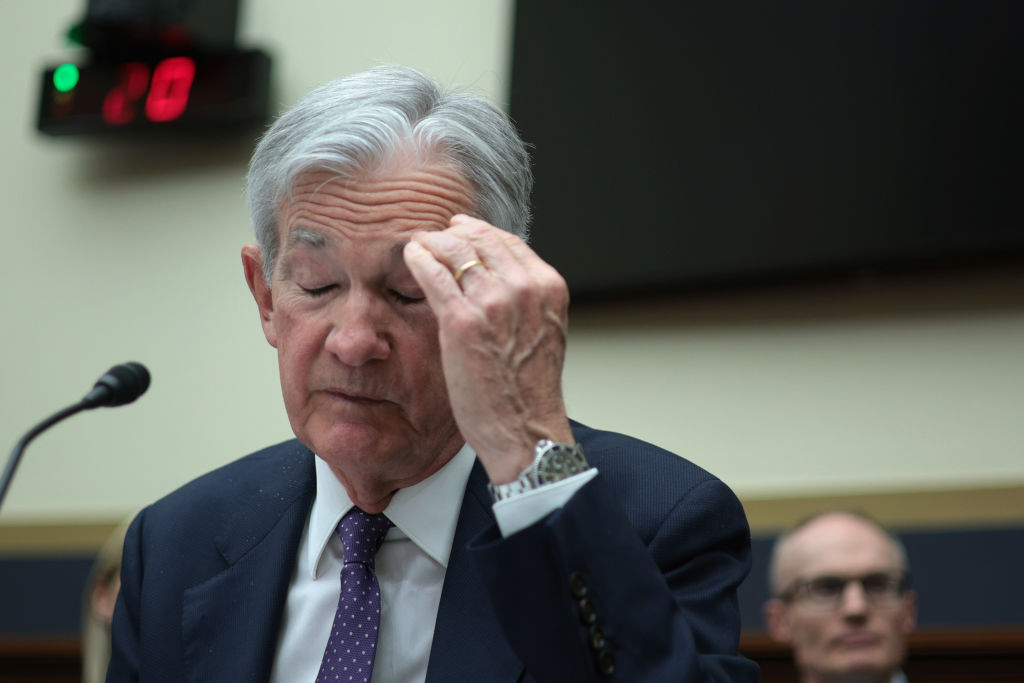It is appropriate in this conclusion to reappraise some of those fundamentals and at the same time consider the link between gold mining share prices and the yellow metal. In doing so, we can satisfy ourselves about the very good reasons for looking upon investments such as the Merrill Lynch Gold & General Fund, as remarkable long-term investment opportunities.
Investing in gold: why you should vote for gold
Overwhelmingly, the plight of the dollar and the scale of the US current account deficit will underpin the future gold price. The reasons for this are to be found in the words of George Bernard Shaw:
"You have to choose as a voter between trusting to the natural stability of gold and the natural stability and intelligence of the members of the government. And with due respect to these gentleman, I advise you as long as the capital system lasts, to vote for gold."
MoneyWeek
Subscribe to MoneyWeek today and get your first six magazine issues absolutely FREE

Sign up to Money Morning
Don't miss the latest investment and personal finances news, market analysis, plus money-saving tips with our free twice-daily newsletter
Don't miss the latest investment and personal finances news, market analysis, plus money-saving tips with our free twice-daily newsletter
Since January 2001, when gold was priced at about $250oz, its steady rise proves that growing numbers are voting for gold and it is inevitable that this should continue.
This dollar view is well supported by Paul Volcker, former Fed Chairman, who said a year or two ago: "We are consuming about 6% more than we are producing. What holds the world together is a massive flow of capital from abroad. It's what feeds our consumption binge. The United States economy is growing on the savings of the poor. A big adjustment will inevitably become necessary...we are skating on increasingly thin ice..."
To cap that the highly regarded Bill Gross, of Pimco, very recently said, "To be blunt, the dollar must go down".
Investing in gold: why the dollar must fall
The eventual resolution of the American current account deficit cannot be avoided. Its resolution is bound to include a dollar at much lower levels. Holders of dollars, such as central banks, particularly in oil-exporting countries (some of which are unfriendly to the US), and China and Japan, will seek to gradually diversify away from the US dollar. Part of that procedure will almost certainly be an increase in the percentage of gold held in their currency reserves.
There is evidence that this has started. The share of developing nations' foreign exchange reserves held in US dollars have, since 2001, fallen from 70% to 60%. Those central banks overweight US dollars are the ones who are most underweight gold bullion. China has 1% in gold bullion, Saudi Arabia 7% and Russia 9% - this compares to the developed world, where the US holds 58%, the Netherlands 87% and Switzerland 36%.
The logic is hard to dispute. The imbalances riddling the global economy are such that the dollar's decline is inevitable. As its decline develops, so the inevitable attractiveness of gold will become more apparent. It is for that reason that in spite of periodic setbacks we think it is certain that gold will rise much higher and in due course test $1,000oz.
Investing in gold: commodities are now seen as an investment class
Alongside the inevitable move from dollars to gold is the awakening of investment interest by institutional and private investors. Commodities, including gold, have now become an accepted asset class.
We see no lessening of that development, particularly because since the launch of Exchanged Traded Funds it is now so easy to own gold bullion without the problems of storage or insurance. Since their launch, 14.5 million ounces have moved into the ETFs, equivalent to 18% of annual mine production.
This is happening at a time of supply constraints, caused by the sharply lower exploration expenditure that occurred up to the late 1990s. It has only increased in the last two years. Couple that with skill and equipment shortages and it means a considerable time-lag before supply can meaningfully increase to soak up the growing demand.
The other additional source of supply is central bank sales. These continue at the rate of about 500,000 ounces per annum and may prove for those suffering deficits a tempting option. So far central banks sales have not subdued the market. The Bank of England poses no risk because Gordon Brown cleared out much of our gold reserves and in doing so set the low for gold bullion at $250oz.
Investing in gold: why gold mining shares will outperform gold
There is a gearing effect from owning the shares rather than the metals. According to Merrill Lynch, over the last five years gold bullion has risen by 146.5%, but their Gold funds have risen by 479.7%. It is relatively simple to extrapolate those figures forward and consider the potential benefit for holding gold mining shares if the gold bullion price is to rise to $1,000oz.
As we explain below, the price today for gold mining shares relative to gold bullion is extremely favourable and from here we would expect a protracted period of out-performance of shares versus the metal. Even if the gold price falls further, which it might, share prices should fall by less and once the gold price stabilises and starts to rise, the rise in share prices is likely to be very significant indeed.
As we have explained before, the long-term relationship between the shares and the metal is best measured by using a ratio calculated by dividing the gold price by the price of the Philadelphia Gold and Silver Index.
This ratio was very recently at five. It generally moves from five to three then back again. The last time the ratio was five was in May 2005. In the year that followed MLG&G rose by 100%.
MLG&G has recently retraced to a decent support (30 week moving average). Generally speaking in a long-term bull market retracements to the 30-week moving average happen repeatedly and represent a level at which we expect support and a return to growth.
Coincidently, the view recently expressed by Graham Birch, who runs MLG&G, is that gold mining companies' profitability in 2006 is likely to improve because previously rising costs should stabilise and that would mean that their margins will improve and therefore shareholder returns should move sharply higher.
At RHAM we are very comfortable to maintain core holdings in these investments which should, over the next few years, continue to deliver significantly above-average returns.
By John Robson & Andrew Selsby at RH Asset Management Limited, as published in the Onassis Newsletter, a fortnightly newsletter that gives insight into the investment markets.
Recommended further reading:
To find out where gold is heading in the future, see: What next for gold. If you would like to know more about investing in gold mining shares, click here: Why gold mining shares look cheap.
For more from RHAM, visit https://www.rhasset.co.uk/
And for more on how to invest in gold, see the report below:
Get the latest financial news, insights and expert analysis from our award-winning MoneyWeek team, to help you understand what really matters when it comes to your finances.
MoneyWeek is written by a team of experienced and award-winning journalists, plus expert columnists. As well as daily digital news and features, MoneyWeek also publishes a weekly magazine, covering investing and personal finance. From share tips, pensions, gold to practical investment tips - we provide a round-up to help you make money and keep it.
-
 UK sets out crypto regulatory proposals
UK sets out crypto regulatory proposalsThe government has tabled legislation that sets out a regulatory framework for cryptocurrencies, while the regulator will consult on balancing innovation and consumer protections
-
 What does an interest rate cut mean for my pension?
What does an interest rate cut mean for my pension?Interest rates have been cut from 4% to 3.75%. For pension savers and retirees the effects of the drop will depend on the type of retirement pot they have, but could be significant.
-
 The challenge with currency hedging
The challenge with currency hedgingA weaker dollar will make currency hedges more appealing, but volatile rates may complicate the results
-
 Can Donald Trump fire Jay Powell – and what do his threats mean for investors?
Can Donald Trump fire Jay Powell – and what do his threats mean for investors?Donald Trump has been vocal in his criticism of Jerome "Jay" Powell, chairman of the Federal Reserve. What do his threats to fire him mean for markets and investors?
-
 Freetrade’s new easy-access funds aim to beat top savings rates
Freetrade’s new easy-access funds aim to beat top savings ratesFreetrade has launched an easy-access exchange traded fund (ETF) range - here’s how the ETFs work and how they compare to the savings market
-
 Go for value stocks to insure your portfolio against shocks, says James Montier
Go for value stocks to insure your portfolio against shocks, says James MontierInterview James Montier, at investment management group GMO, discusses value stocks and slow-burn Minsky moments with MoneyWeek.
-
 Where do we go from here?
Where do we go from here?Features A new series of interviews from MoneyWeek
-
 As China reopens, why pick an income strategy?
As China reopens, why pick an income strategy?Advertisement Feature Yoojeong Oh, Investment Manager, abrdn Asian Income Fund Limited
-
 Income in the USA
Income in the USAAdvertisement Feature Fran Radano, manager on The North American Income Trust
-
 The challenge of turbulent markets
The challenge of turbulent marketsAdvertisement Feature Today, ISA investors face one of the most challenging economic environments seen in recent years. However, good companies can still thrive, even in the toughest economic conditions. That’s why BlackRock’s fund managers focus on these businesses when they’re looking for investment opportunities.

